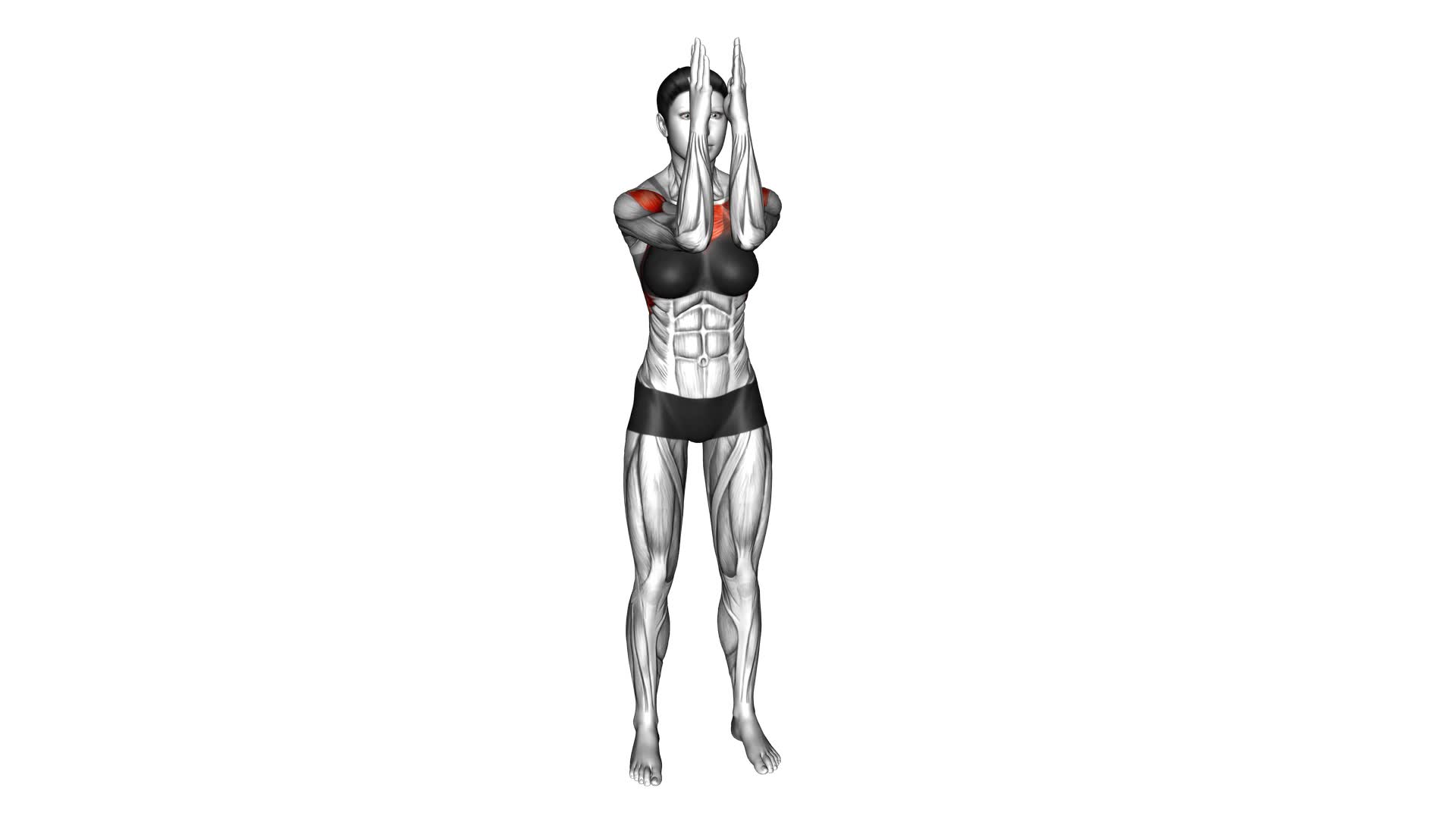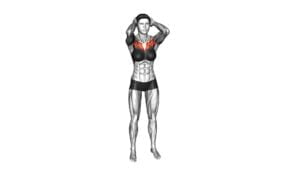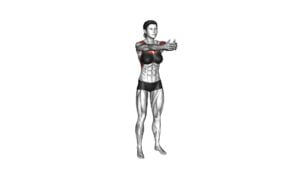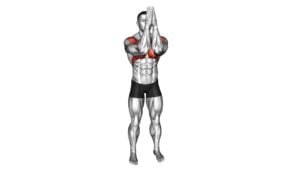Bodyweight Standing Fly (female) – Video Exercise Guide & Tips

Are you looking for an effective and efficient exercise to target your upper body? Look no further than the bodyweight standing fly!
Watch This Exercise Video
This exercise is specifically designed for females, and our video exercise guide and tips will show you the proper form and technique.
With variations and modifications available, you can customize the workout to your fitness level.
Avoid common mistakes and maximize your results with our expert advice.
Get ready to sculpt and strengthen your upper body with the bodyweight standing fly!
Key Takeaways
- Bodyweight Standing Fly targets multiple muscle groups simultaneously
- It improves upper body strength and aesthetics
- Proper form and technique are essential for maximizing effectiveness
- Variations and modifications can be made to increase difficulty and challenge balance and stability
Benefits of Bodyweight Standing Fly
One major benefit of the Bodyweight Standing Fly is that it targets multiple muscle groups simultaneously. This exercise is highly effective for muscle activation and core stability. By performing the Bodyweight Standing Fly, you engage your chest, shoulders, and back muscles all at once. This means that you're maximizing your workout efficiency and saving time by targeting multiple areas of your body in a single exercise.
Muscle activation is crucial for building strength and increasing muscle tone. The Bodyweight Standing Fly activates your chest muscles, specifically the pectoralis major and minor, as well as the deltoids in your shoulders. Additionally, the muscles in your upper back, such as the rhomboids and trapezius, are also engaged during this exercise. This comprehensive muscle activation helps to improve upper body strength and aesthetics.
Core stability is another key benefit of the Bodyweight Standing Fly. As you perform the exercise, your core muscles work to stabilize your body and maintain proper form. This includes muscles such as the rectus abdominis, obliques, and transverse abdominis. By strengthening your core, you improve your overall balance and stability, which can have a positive impact on your performance in other exercises and daily activities.
Proper Form and Technique
To perform the Bodyweight Standing Fly exercise with proper form and technique, you should begin by standing with your feet shoulder-width apart. This will provide a stable base and help improve balance throughout the exercise. Start by extending your arms straight out to the sides at shoulder height, with your palms facing forward. Engage your core muscles to maintain a stable and upright posture throughout the movement.
Next, gently squeeze your shoulder blades together as you bring your arms forward, crossing them in front of your body. Be sure to keep your arms at shoulder height and maintain a slight bend in your elbows. This motion targets the muscles of the chest, specifically the pectoralis major and minor.
As you return to the starting position, focus on controlling the movement and keeping tension in your chest muscles. Avoid swinging your arms or using momentum to complete the exercise. Keep your movements slow and controlled for maximum benefit.
Variations and Modifications
For different ways to challenge yourself and tailor the exercise to your fitness level, try out variations and modifications of the Bodyweight Standing Fly. There are different progression levels and equipment options that can be incorporated into this exercise to make it more challenging or to accommodate different fitness levels.
To increase the difficulty of the Bodyweight Standing Fly, you can try using resistance bands or dumbbells. Adding resistance will engage your muscles more intensely and help you build strength. Start with lighter weights or lower resistance bands and gradually increase as you become more comfortable and stronger.
If you don't have access to equipment, you can still modify the exercise by changing the position of your arms. Instead of performing the fly motion with your arms extended straight out to the sides, you can try bringing your hands closer to your chest or crossing them in front of your body. This variation will target different muscles and provide a new challenge.
Another modification you can try is performing the exercise on one leg. This will challenge your balance and stability, as well as engage your leg muscles more intensely. Start by lifting one foot slightly off the ground and gradually increase the duration as you become more comfortable.
Common Mistakes to Avoid
To ensure you perform the Bodyweight Standing Fly correctly and get the most out of your workout, it's important to avoid common mistakes. By understanding these mistakes and practicing proper technique, you can maximize the effectiveness of this exercise.
One common mistake to avoid is using too much weight. It may be tempting to grab heavy dumbbells, but using excessive weight can compromise your form and increase the risk of injury. It's better to start with lighter weights and focus on maintaining proper form throughout the movement.
Another mistake to avoid is swinging your arms or using momentum. The Bodyweight Standing Fly is meant to target your chest and shoulder muscles, and swinging your arms takes away from the effectiveness of the exercise. Instead, focus on controlled movements and engage your muscles throughout the entire range of motion.
Improper posture is also a common mistake. It's important to maintain a tall and stable posture throughout the exercise. Avoid hunching your shoulders or rounding your back. Engage your core and keep your chest lifted to ensure proper alignment and maximize the benefits of the exercise.
Lastly, rushing through the exercise is a mistake that many people make. Take your time and perform each repetition with control and precision. This will allow you to fully engage your muscles and get the most out of the exercise.
Tips for Maximizing Results
To maximize your results with the Bodyweight Standing Fly, focus on proper form and technique. Here are some tips to help you get the most out of this exercise:
- Nutrition tips for maximizing results:
- Fuel your body with the right nutrients by consuming a balanced diet that includes lean proteins, complex carbohydrates, and healthy fats.
- Stay hydrated by drinking plenty of water throughout the day. Proper hydration is essential for muscle function and overall performance.
- Consider incorporating supplements such as protein powder or branched-chain amino acids (BCAAs) to support muscle recovery and growth.
- Recovery strategies for maximizing results:
- Allow your body enough time to recover between workouts. Rest days are just as important as your training days.
- Prioritize quality sleep to promote muscle repair and growth. Aim for 7-9 hours of uninterrupted sleep each night.
- Incorporate active recovery activities like stretching, foam rolling, or yoga to improve flexibility and reduce muscle soreness.
Frequently Asked Questions
What Are the Muscles Targeted by the Bodyweight Standing Fly Exercise?
The bodyweight standing fly exercise targets multiple muscles in your upper body. It helps to strengthen and tone your chest muscles, specifically the pectoralis major and minor. Additionally, it engages your shoulders, triceps, and core muscles for stability and balance.
This exercise is a great way to incorporate bodyweight movements into your workout routine, offering the benefits of convenience, versatility, and increased muscle activation. You can also try variations of the bodyweight standing fly to challenge yourself further.
Can the Bodyweight Standing Fly Exercise Be Done by Beginners?
Yes, the bodyweight standing fly exercise can be done by beginners. There are modifications available to make it more accessible for those just starting out.
It's important to start with lighter weights or no weights at all, focusing on proper form and technique. Common mistakes to avoid include using too much weight, rounding the shoulders, or overextending the arms.
Remember to engage the chest muscles and keep a controlled and steady movement throughout the exercise.
How Many Sets and Repetitions Should Be Performed for Optimal Results?
To achieve optimal results with the bodyweight standing fly exercise, you should perform multiple sets and repetitions.
Incorporating bodyweight exercises into your workout routine offers numerous benefits such as improving strength, stability, and muscle tone.
The variations of the bodyweight standing fly exercise allow you to target different muscles and add variety to your workout.
Remember to listen to your body and start with a manageable number of sets and repetitions, gradually increasing as you become more comfortable and stronger.
Is It Necessary to Use Resistance Bands or Dumbbells for the Bodyweight Standing Fly Exercise?
No, it isn't necessary to use resistance bands or dumbbells for the bodyweight standing fly exercise. The bodyweight standing fly exercise can be performed without any external equipment.
However, if you want to increase the intensity of the exercise, you can incorporate resistance bands or dumbbells. This will provide added resistance and help you target your chest muscles more effectively.
There are various variations of the bodyweight standing fly exercise that can be done with or without additional equipment.
Are There Any Specific Breathing Techniques to Follow During the Bodyweight Standing Fly Exercise?
During the bodyweight standing fly exercise, it's important to focus on your breathing. Take a deep breath in as you bring your arms out to the sides, and exhale as you return them to the starting position. This helps to engage your core and stabilize your body.
One common mistake to avoid is holding your breath or breathing shallowly. Remember to breathe deeply and rhythmically throughout the exercise for optimal results.
Conclusion
To maximize the results of the bodyweight standing fly exercise, it's crucial to maintain proper form and technique. By engaging the chest muscles and keeping the core stable, this exercise can help improve upper body strength and posture.
Avoid common mistakes such as using momentum or neglecting to fully extend the arms. Remember to listen to your body and adjust the exercise to your fitness level.
With consistency and focus, you can achieve great results with the bodyweight standing fly.

Author
Years ago, the spark of my life’s passion ignited in my mind the moment I stepped into the local gym for the first time. The inaugural bead of perspiration, the initial endeavor, the very first surge of endorphins, and a sense of pride that washed over me post-workout marked the beginning of my deep-seated interest in strength sports, fitness, and sports nutrition. This very curiosity blossomed rapidly into a profound fascination, propelling me to earn a Master’s degree in Physical Education from the Academy of Physical Education in Krakow, followed by a Sports Manager diploma from the Jagiellonian University. My journey of growth led me to gain more specialized qualifications, such as being a certified personal trainer with a focus on sports dietetics, a lifeguard, and an instructor for wellness and corrective gymnastics. Theoretical knowledge paired seamlessly with practical experience, reinforcing my belief that the transformation of individuals under my guidance was also a reflection of my personal growth. This belief holds true even today. Each day, I strive to push the boundaries and explore new realms. These realms gently elevate me to greater heights. The unique combination of passion for my field and the continuous quest for growth fuels my drive to break new ground.







